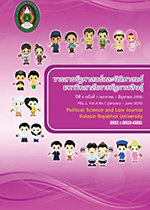การนำโครงการรับจำนำข้าวเปลือกของรัฐบาล ยิ่งลักษณ์ ชินวัตร ไปสู่การปฏิบัติ : กรณีศึกษาตำบลนาแก อำเภอ คำเขื่อนแก้ว จังหวัดยโสธร
DOI:
https://doi.org/10.14456/gjl.2015.11คำสำคัญ:
นโยบายสาธารณะ, โครงการรับจำนำข้าว, Public Policy, The Rice Pledging Schemeบทคัดย่อ
การศึกษาวิจัยครั้งนี้มีวัตถุประสงค์ 1) เพื่อศึกษาขั้นตอนการนำโครงการรับจำนำข้าวเปลือกของรัฐบาล ยิ่งลักษณ์ ชินวัตร ไปปฏิบัติ ในตำบลนาแก อำเภอคำเขื่อนแก้ว จังหวัดยโสธร และ 2) เพื่อศึกษาเปรียบเทียบปัญหาการนำโครงการรับจำนำข้าวเปลือกของรัฐบาล ยิ่งลักษณ์ ชินวัตร ไปปฏิบัติ ในตำบลนาแก อำเภอคำเขื่อนแก้ว จังหวัดยโสธรกับปัญหาการนำโครงการรับจำนำข้าวเปลือกในระดับประเทศ วิธีดำเนินการวิจัยใช้รูปแบบการวิจัยเชิงคุณภาพ เก็บรวบรวมข้อมูลจากเอกสาร การสัมภาษณ์แบบเจาะลึกจากผู้ให้ข้อมูลสำคัญผู้วิจัยวิเคราะห์ข้อมูลโดยใช้การจำแนกข้อมูล, การวิเคราะห์ข้อมูล, การวิเคราะห์เนื้อหา, และการเปรียบเทียบข้อมูล ตามตัวแบบการนำนโยบายไปปฏิบัติของวรเดช จันทรศรผลการศึกษาพบว่า ขั้นตอนการนำโครงการรับจำนำข้าวเปลือกของรัฐบาลยิ่งลักษณ์ ชินวัตร ไปปฏิบัติ ในตำบลนาแก อำเภอคำเขื่อนแก้ว จังหวัดยโสธร ประกอบด้วย 3 ขั้นตอน ผลการศึกษาปัญหาโครงการรับจำนำข้าวเปลือก พบว่า 1) ปัญหาด้านสมรรถนะ ประกอบด้วย 1.1) ปัจจัยด้านบุคลากร นั่นคือ เจ้าหน้าที่มีจำนวนจำกัดและขาดความรู้ความเข้าใจ 1.2) ปัจจัยด้านเงินทุน นั่นคือ ข้อจำกัดด้านงบประมาณและแหล่งเงินทุน1.3) ปัจจัยด้านเครื่องมือและอุปกรณ์ นั่นคือใบประทวนมีจำนวนจำกัด 2) ปัญหาด้านการควบคุมนั่นคือ ปัญหาตรวจวัดความชื้นและสิ่งเจือปน 3) ปัญหาด้านความร่วมมือและการต่อต้านการเปลี่ยนแปลง พบว่า มีความขัดแย้งระหว่างเจ้าหน้าที่ผู้ปฏิบัติงานกับผู้มีส่วนได้ส่วนเสีย 4) ปัญหาด้านอำนาจและความสัมพันธ์กับองค์การอื่นที่เกี่ยวข้อง พบว่า ผู้ประกอบการโรงสีใช้อำนาจในทางมิชอบต่อกฎหมาย 5) ปัญหาด้านการสนับสนุนและความผูกพันขององค์การหรือบุคคลสำคัญในกระบวนการของการนำนโยบายไปปฏิบัติ ได้แก่ ผู้ประกอบการโรงสีเห็นแก่ประโยชน์ส่วนตัวมากกว่าส่วนรวม
The objectives of the study were to 1) Study the process of the rice pledging scheme of Yingluck Shinawatra Government in Na Kae Subdistrict Kham Khuean Kaeo District Yasothon Province, and 2) to study compare the problems of the rice pledging scheme of Yingluck Shinawatra in Na Kae Subdistrict Kham Khuean Kaeo District Yasothon Province with the problems of the rice pledging scheme nationally. This study used qualitative research approach. Data were collected from the related documents, and the in-depth interview of key informant. The typological content and comparison analysis were used based on Voradaj Chandarasorn,s policy implementation model.
The result of the study found that there were 3 steps of the rice pledging scheme of Yingluck Shinawatra Government in Na Kae Subdistrict Kham Khuean Kaeo District Yasothon Province. The study revealed problems of the rice pledging scheme as follows: 1) Capacity problems include 1.1) Individual factor i.e. limited of staff and lake of knowledge 1.2) Capital facto i.e. financial resources 1.3) Devices factors i.e. adequacy of warehouse receipt 2) Controlling problems i.e. moisture and impurities examination 3) Coordination resistance to change i.e. conflict between officials and stakeholder 4) Authority and relationship with other organization problems i.e. mill operators used illegal authority 5) support and commitment of organization and individual i.e. mill operatorsfocus on their own interest rather than common interest.
Downloads
ดาวน์โหลด
เผยแพร่แล้ว
รูปแบบการอ้างอิง
ฉบับ
ประเภทบทความ
สัญญาอนุญาต
ลิขสิทธิ์ (c) 2017 วารสารการบริหารปกครอง (Governance Journal)

อนุญาตภายใต้เงื่อนไข Creative Commons Attribution-NonCommercial-NoDerivatives 4.0 International License.








